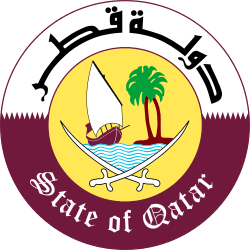Ahmad bin Ali Al Thani
| Ahmad bin Ali Al Thani أحمد بن علي آل ثاني | |||||
|---|---|---|---|---|---|
| Emir of Qatar | |||||
| Reign | 24 October 1960 – 22 February 1972 | ||||
| Coronation | 24 October 1960 | ||||
| Predecessor | Ali bin Abdullah Al Thani | ||||
| Successor | Khalifa bin Hamad Al Thani | ||||
| Born |
1920 Doha, Qatar | ||||
| Died |
25 November 1977 London | ||||
| Burial | Al Rayyan Cemetery | ||||
| Issue |
Abdulaziz bin Ahmad Al Thani Nasser bin Ahmad Al Thani Hamad bin Ahmad Al Thani Saud bin Ahmad Al Thani Abdullah bin Ahmad Al Thani Khalid bin Ahmad Al Thani Mansur bin Ahmad Al Thani | ||||
| |||||
| House | Al Thani | ||||
| Dynasty | Al Thani | ||||
| Father | Ali bin Abdullah Al Thani | ||||
| Styles of The Emir of Qatar | |
|---|---|
 | |
| Reference style | His Highness |
| Spoken style | Your Highness |
| Alternative style | Sheikh |
Sheikh Ahmad bin Ali bin Abdullah bin Jassim bin Mohammed Al Thani, (1920–1977) (Arabic: أحمد بن علي بن عبد الله بن جاسم بن محمد آل ثاني), also known as Sheikh Ahmad bin Ali Al Thani for short, was the Emir of Qatar who ruled from 1960 to 1972. Qatar's financial status witnessed significant improvements during his reign as a result of the enrichment and discovery of several new oil fields. Qatar also gained its independence as a sovereign state in September 1971 under his rule.[1] He was deposed in February 1972 by his cousin, Khalifa bin Hamad Al Thani.[2]
Biography
Early life and deposition
Sheikh Ahmad was born in Doha, the capital city and state of Qatar, in 1920 as the 2nd son of Sheikh Ali bin Abdullah Al Thani, along with his 12 siblings, to be exact, he had 9 brothers and 3 sisters, although some sources prove that he had 10 brothers instead of 9.[3]
He took the throne on 24 October 1960 after his father, Sheikh Ali bin Abdullah Al Thani, abdicated in favor of him.[3][4] Sheikh Ahmad then assumed throne and became the emir through the final years of dependency, presiding over its independence from the Great Britain in 1971. Sheikh Ahmad attended numerous royal coronations, including the Coronation of Queen Elizabeth II at Westminster Abbey in 1953.[3] On the same date his reign began, his cousin Sheikh Khalifa bin Hamad Al Thani was appointed as the heir apparent and deputy ruler. On 22 February 1972 Sheikh Khalifa deposed him.[2] During the incident, Sheikh Ahmad was in Iran for hunting trip.[2] After his deposition, Sheikh Ahmad lived in exile in Dubai with his wife the daughter of the late ruler of dubai and children, in the emirate of the United Arab Emirates.[1][3]
Reign
1963 Arab Nationalism movements
In April 1963, a nationalist labor group known as the National Unity Front was formed in response to a relative of Sheikh Ahmad opening fire on a nationalist demonstration and killing a protester. The demonstration had been organized by North Yemeni migrant workers who supported their government's union with the United Arab Republic. The group's formation was precipitated by public dissent with the ruling family's extravagant lifestyles and Sheikh Ahmed's long absences abroad since he ascended to the throne in 1960.[5] Co-founded by a wealthy businessman and a tribal leader, the group soon gained popularity among Arab nationalists, individuals sympathetic to the Ba'ath Party and Qatari laborers.[6][7]
They staged a mini-uprising in the central Doha market that year in response to the shooting where they presented their demands to the government. Some of these demands would have hindered Sheikh Ahmad's power.[8] The government rejected all these demands, and amid a tense atmosphere, many of the National Unity Front members were arrested and detained without trial.[6] However, Sheikh Ahmad did institute some reforms, such as the provision of land and loans to poor farmers.
Achievements
Economic Achievements
Sheikh Ahmad's rule witnessed the growing economic activities in the country as the result of the discovery of a large number of oil fields in Qatar. At that time, and in January 1964, full-scale production commenced in the Idd al-Shargi field, the first seabed field in the world to be operated entirely as an offshore facility.[1] Moreover, in 1963, the larger field at Maydan Mahzam was discovered and in 1965 an oil terminal was set up on the Island of Halul. Exploration of the Bul Hannien field started in 1965 and production commenced in 1977.[1] With the growth of oil economy, Qatar moved rapidly towards the introduction of modern administrative system. Sheikh Ahmad established the Ministry of Finance in November 1960 and Sheikh Khalifa, the Heir Apparent and Deputy Ruler at that time, was appointed as the first Minister of Finance.[1] After that, Sheikh Ahmed established The Department of General Financial and Administration in order to handle all governmental affairs of a financial and administrative nature.[1] Then, in 1967, the Department of Civil Service was also set up.[1]
The Independence of Qatar
Gradually the administration of Qatar began to take final shape and the country moved for independence. Following the British Labour Government's announcement in January 1968, for withdrawal from the East of Suez terminating the Treaties of Protection with the Gulf Rulers and their failure to form a Confederation of the Nine Gulf States, Qatar moved forward for forming a Cabinet. On 2 April 1970, the Provisional Constitution for Qatar was promulgated and the first Council of Ministers of the country was formed on 28 May 1970. The independence of Qatar as a sovereign state terminating the Anglo-Qatari Treaty of 1916 was declared on 3 September 1971.[1]
Marriage and children
Sheikh Ahmad bin Ali Al Thani had married three women one of them the daughter of Shaikh Rashid bin Said Al Maktum, the Ruler of Dubai.[9] He had 8 children, 7 sons and 1 daughter. Note that this list is in descending order according to their age, from the eldest son to the youngest.
- Sheikh Abdulaziz bin Ahmad Al Thani
- Sheikh Nasser bin Ahmad Al Thani
- Sheikh Hamad bin Ahmad Al Thani
- Sheikh Saud bin Ahmad Al Thani
- Sheikha Muneera bint Ahmad Al Thani
- Sheikh Abdullah bin Ahmad Al Thani
- Sheikh Khalid bin Ahmad Al Thani
- Sheikh Mansur bin Ahmad Al Thani
Death
Though some reconciliation was achieved with his cousin Sh Ahmed elected to remain in excite and died in London while getting treated for cancer on the 25th of November 1977 and his body was flown back to Qatar and received by the ruling family and he received a formal funeral which was attended by the Emir and ruling family and buried in Al Rayyan cemetery and a three day mourning period was announced.[1]
References
- 1 2 3 4 5 6 7 8 9 "Shaikh Ahmed Bin Ali Al Thani: Amiri Diwan". Diwan. Retrieved 10 November 2012.
- 1 2 3 "Qatar PM seizes power from cousin". Ottawa Citizen. Beirut. AP. 23 February 1972. Retrieved 27 June 2013.
- 1 2 3 4 Buyers, Christopher. "The Al Thani Dynasty (page 6)". Royal Ark. Retrieved 10 November 2012.
- ↑ Rathmell, Andrew; Kirsten Schulze (October 2000). "Political Reform in the Gulf: The Case of Qatar". Middle Eastern Studies. 36 (4): 47–62. doi:10.1080/00263200008701331. JSTOR 4284113.
- ↑ Hiro, Dilip (2014). Inside the Middle East. Routledge. p. 15. ISBN 978-0415835084.
- 1 2 Kadhim, Abbas (2013). Governance in the Middle East and North Africa: A Handbook. Routledge. p. 258. ISBN 978-1857435849.
- ↑ Commins, David (2012). The Gulf States: A Modern History. I. B. Tauris. p. 188. ISBN 978-1848852785.
- ↑ "Qatar - Historical Background". countrystudies.us. Retrieved 23 January 2015.
- ↑ Peterson, J. E. (2007). "Rulers, Merchants and Shaikhs in Gulf Politics" (PDF). The Gulf Family. Retrieved 17 April 2013.
| Ahmad bin Ali Al Thani Born: 1920 Died: 25 November 1977 | ||
| Regnal titles | ||
|---|---|---|
| Preceded by Ali bin Abdullah Al-Thani |
Emir of Qatar 1960 – 1972 (in exile – 1977) |
Succeeded by Khalifa bin Hamad Al Thani |
